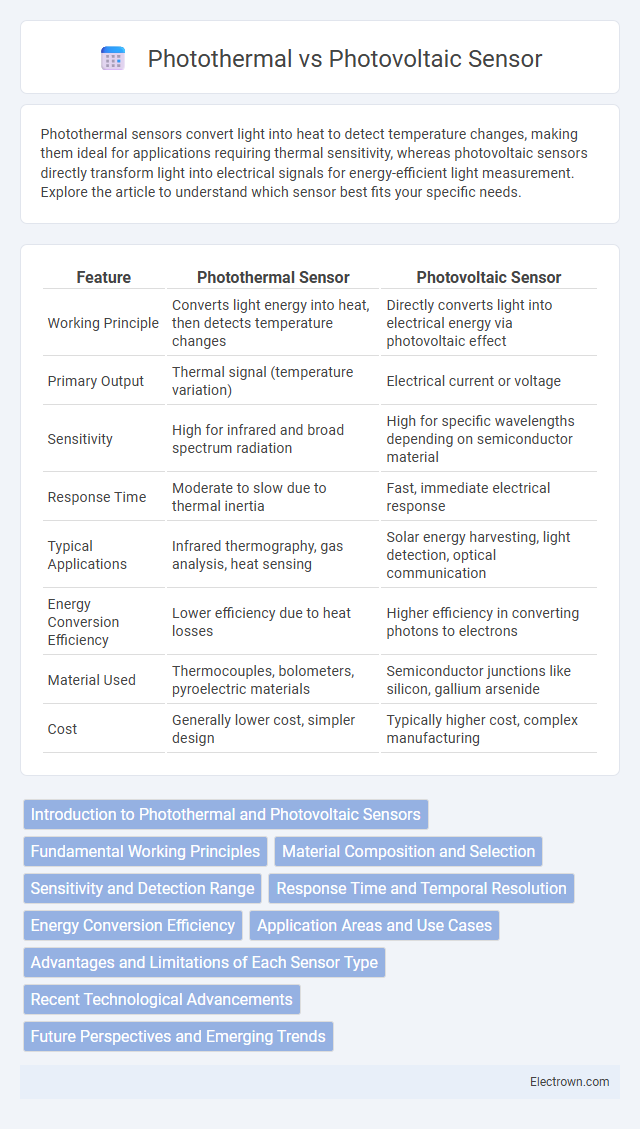Photothermal sensors convert light into heat to detect temperature changes, making them ideal for applications requiring thermal sensitivity, whereas photovoltaic sensors directly transform light into electrical signals for energy-efficient light measurement. Explore the article to understand which sensor best fits your specific needs.
Table of Comparison
| Feature | Photothermal Sensor | Photovoltaic Sensor |
|---|---|---|
| Working Principle | Converts light energy into heat, then detects temperature changes | Directly converts light into electrical energy via photovoltaic effect |
| Primary Output | Thermal signal (temperature variation) | Electrical current or voltage |
| Sensitivity | High for infrared and broad spectrum radiation | High for specific wavelengths depending on semiconductor material |
| Response Time | Moderate to slow due to thermal inertia | Fast, immediate electrical response |
| Typical Applications | Infrared thermography, gas analysis, heat sensing | Solar energy harvesting, light detection, optical communication |
| Energy Conversion Efficiency | Lower efficiency due to heat losses | Higher efficiency in converting photons to electrons |
| Material Used | Thermocouples, bolometers, pyroelectric materials | Semiconductor junctions like silicon, gallium arsenide |
| Cost | Generally lower cost, simpler design | Typically higher cost, complex manufacturing |
Introduction to Photothermal and Photovoltaic Sensors
Photothermal sensors detect infrared radiation by measuring temperature changes caused by absorbed light, converting thermal energy into a measurable signal. Photovoltaic sensors generate electrical current directly from light through the photoelectric effect, converting photons into electrons. Both technologies are integral to optical detection but differ fundamentally in their sensing mechanisms and applications.
Fundamental Working Principles
Photothermal sensors detect infrared radiation by measuring the temperature change in a material caused by absorbed light, relying on heat generation and its effect on the sensor's physical properties. Photovoltaic sensors convert light directly into electrical current through the photovoltaic effect, where photons excite electrons across a semiconductor junction. The photothermal mechanism depends on thermal conductivity and heat capacity, while the photovoltaic approach hinges on semiconductor bandgap properties and charge carrier dynamics.
Material Composition and Selection
Photothermal sensors primarily rely on materials with high thermal conductivity and low heat capacity, such as metals like gold or platinum, to efficiently convert absorbed light into heat for temperature detection. Photovoltaic sensors utilize semiconductor materials including silicon, gallium arsenide, or perovskites, which exhibit strong photoelectric effects to directly convert light into electrical signals. Selecting materials for photothermal sensors emphasizes thermal responsiveness and stability, while photovoltaic sensor materials are chosen for bandgap energy, charge carrier mobility, and spectral sensitivity.
Sensitivity and Detection Range
Photothermal sensors exhibit higher sensitivity and broader detection range compared to photovoltaic sensors due to their ability to measure subtle temperature changes induced by absorbed radiation. Photovoltaic sensors directly convert light into electrical signals but often have limited sensitivity in low-light conditions and narrower wavelength detection ranges. Your choice between photothermal and photovoltaic sensors should consider the specific application requirements for detection sensitivity and spectral response.
Response Time and Temporal Resolution
Photothermal sensors exhibit slower response times, typically ranging from milliseconds to seconds, due to the thermal diffusion processes involved, which limits their temporal resolution. Photovoltaic sensors provide rapid response times in the microsecond to nanosecond range, enabling high temporal resolution crucial for real-time applications. The intrinsic material properties of photovoltaic devices, such as semiconductor bandgap and carrier mobility, directly influence their superior speed compared to photothermal mechanisms reliant on heat transfer.
Energy Conversion Efficiency
Photothermal sensors convert light into heat, demonstrating moderate energy conversion efficiency typically around 30-40%, influenced by the material's thermal properties and heat dissipation rates. Photovoltaic sensors directly convert light into electrical energy, achieving higher efficiency levels ranging from 15% to over 25%, depending on semiconductor quality and device architecture. The superior energy conversion efficiency of photovoltaic sensors makes them more suitable for applications requiring direct electrical output and energy harvesting.
Application Areas and Use Cases
Photothermal sensors excel in applications such as gas detection, environmental monitoring, and industrial process control due to their sensitivity to trace gases and heat-based measurements. Photovoltaic sensors find widespread use in solar energy harvesting, optical communication systems, and light intensity monitoring, benefiting from their direct conversion of light to electrical energy. Both sensor types contribute significantly to fields like environmental science, renewable energy, and safety systems, where precise detection and energy efficiency are critical.
Advantages and Limitations of Each Sensor Type
Photothermal sensors offer high sensitivity to temperature changes and can detect a wide range of wavelengths, making them ideal for precise thermal measurements in infrared spectroscopy, but they often require complex calibration and are slower in response time. Photovoltaic sensors convert light directly into electrical signals with fast response times and high efficiency, suitable for solar energy applications and optical communication, though their performance is limited by spectral response range and susceptibility to temperature variations. Choosing between photothermal and photovoltaic sensors depends on the specific application demands for sensitivity, speed, spectral range, and environmental stability.
Recent Technological Advancements
Recent technological advancements in photothermal sensors include enhanced sensitivity and faster response times through nanomaterial integration and microfabrication techniques, enabling precise temperature mapping at the microscale. Photovoltaic sensors have seen improved energy conversion efficiency and extended spectral response due to innovations in perovskite materials and tandem cell architectures. Your choice between these sensors depends on application requirements such as thermal detection precision or direct electrical energy generation.
Future Perspectives and Emerging Trends
Future perspectives in photothermal sensors emphasize enhanced sensitivity and integration with nanomaterials for improved thermal response and miniaturization. Emerging trends in photovoltaic sensors focus on developing perovskite-based materials and tandem solar cells to increase power conversion efficiency and flexibility. Both technologies are advancing toward smart sensor applications in IoT and wearable devices, leveraging AI-driven data processing for real-time environmental monitoring.
Photothermal vs Photovoltaic Sensor Infographic

 electrown.com
electrown.com